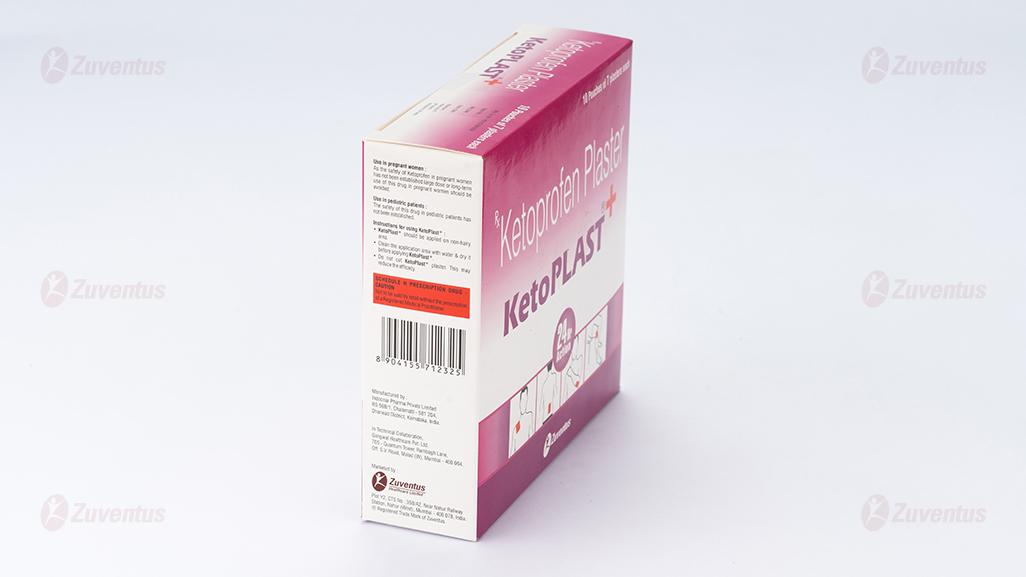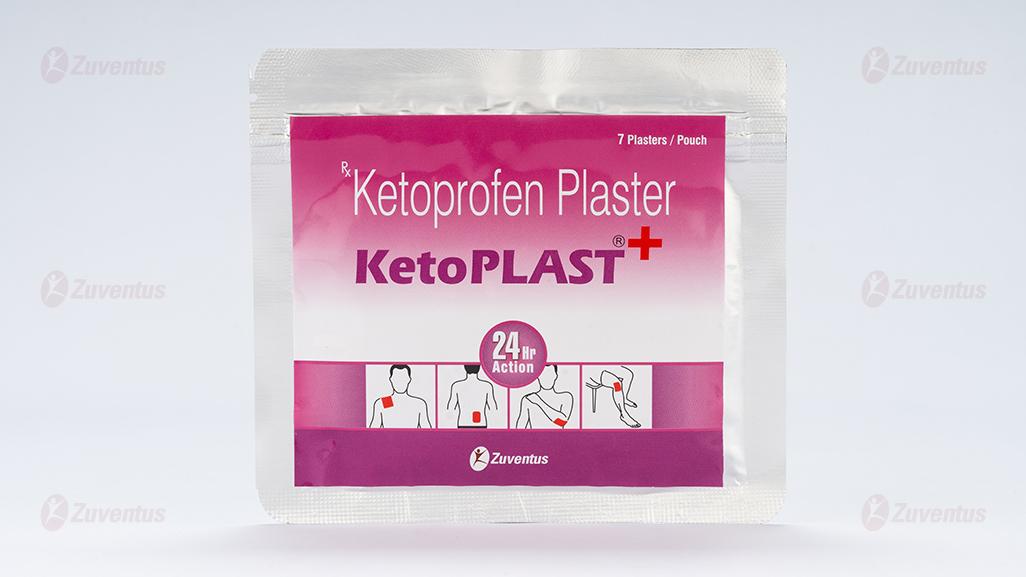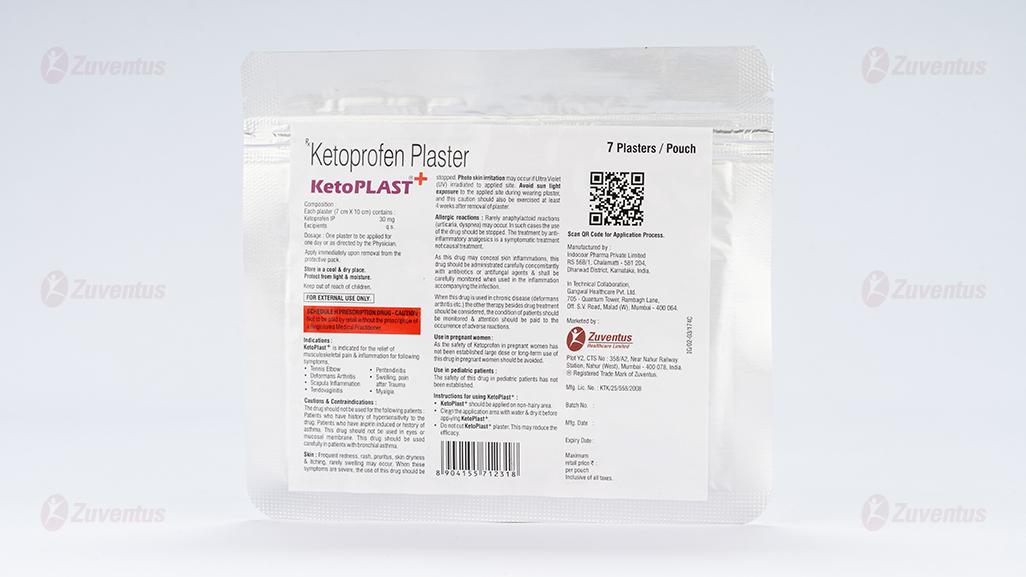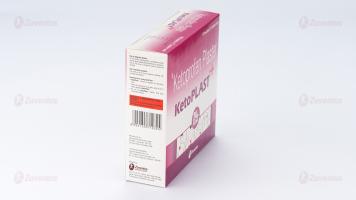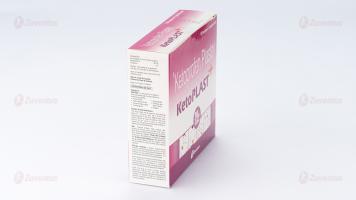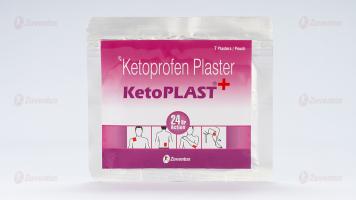Ketoplast
1.0 Generic Name
Ketoprofen Plaster
2.0 Qualitative and quantitative composition
Each plaster (7 cm X 10 cm) contains :
Ketoprofen IP 30 mg
Excipients q.s.
3.0 Dosage form and strength
Medicated Transdermal Patch, 30 mg
4.0 Clinical particulars
4.1. Therapeutic indication
For the relief of musculoskeletal pain and inflammation.
4.2. Posology and method of administration
One patch to be applied for one day or as directed by the Physician.
Method of administration
Clean and dry the affected area before applying the patch. Remove the protective film and apply the adhesive part directly to the skin. If the patch is to be applied to very mobile joints such as the elbow or knee, a bandage can be applied to the joint when bent, to keep the patch in place.
4.3. Contraindications
- Hypersensitivity to the active substance or to any of the excipients listed in the formulation
- known hypersensitivity reactions, such as symptoms of asthma, allergic rhinitis to ketoprofen, fenofibrate, tiaprofenic acid, acetylsalicylic acid, or to other NSAID history of any photosensitivity reaction
- history of skin allergy to ketoprofen, tiaprofenic acid, fenofibrate, UV blockers or perfumes
- sun exposure, even in case of hazy sun, including UV light from solarium, should be avoided during the treatment and 2 weeks after its discontinuation.
- patients in whom substances with a similar mechanism of action (e.g. acetylsalicylic acid or other NSAIDs) cause attacks of asthma, bronchospasm or acute rhinitis, or cause nasal polyps, urticaria or angioedema. • active or suspected gastrointestinal ulcer or a history of gastrointestinal ulcer
- gastrointestinal bleeding or other active bleeding or bleeding disorders
- severe heart failure
- severe hepatic or renal dysfunction
- haemorrhagic diathesis and other coagulation disorders, or patients receiving anticoagulant therapy
- third trimester pregnancy
- children under 12 years of age
- The use on open wounds or on skin with pathological changes such as eczema, acne, dermatitis, inflammation or infection of any nature or on mucous membranes of body orifices is contraindicated.
4.4. Special warnings and precautions for use
- The systemic bioavailability of ketoprofen applied via the transdermal route is significantly lower than that following oral administration. However, it is not possible to exclude completely the onset of systemic side effects, although it is much less likely that these side effects will occur at this level of plasma binding.
- Analgesics, antipyretics and non-steroidal anti-inflammatory drugs (NSAIDs) can cause potentially serious hypersensitivity reactions, including anaphylactic reactions, even in subjects with no previous exposure to this type of drug. The risk of hypersensitivity reactions after the use of ketoprofen is greater in subjects who have already had this type of reaction after using other analgesics, antipyretics and non-steroidal anti-inflammatory drugs (NSAIDs).
- Administer with caution to patients with allergic conditions or a history of allergy. Patients with asthma combined with chronic rhinitis, chronic sinusitis, and/or nasal polyposis have a higher risk of allergy to aspirin and/or NSAIDs than the rest of the population.
- Treatment should be discontinued immediately upon development of any skin reaction including cutaneous reactions. There have been some reported cases of photosensitivity that occurred a few days, and in rare cases a few months, after the use of the drug. If symptoms of dermatitis are observed, discontinue treatment and keep the affected area away from sunlight.
- The recommended length of treatment should not be exceeded due the risk of developing contact dermatitis and photosensitivity reactions increases over time.
- It is recommended to protect treated areas by wearing clothing during all the application of the product and two weeks following its discontinuation to avoid the risk of photosensitisation.
- Special care should be taken for patients with Crohn’s disease or ulcerative colitis, chronic dyspepsia, history of bronchial asthma.
- Patients currently suffering from or with a previous history of gastrointestinal disease should be carefully monitored for digestive disorders, in particular gastrointestinal bleeding. In the rare cases where gastrointestinal bleeding or ulceration occur in patients receiving treatment with ketoprofen, treatment should be discontinued immediately. Like all NSAIDs, the drug can increase plasma urea nitrogen and creatinine.
- As with other inhibitors of prostaglandin synthesis, the drug may be associated with adverse effects on the renal system, which can lead to glomerular nephritis, renal papillary necrosis, nephrotic syndrome and acute renal failure. As with other NSAIDs, the drug can cause transient small increases in some liver parameters, and also significant increases in SGOT and SGPT. In case of a relevant increase in such parameters, therapy must be discontinued.
- Ketoprofen should be used with caution in patients suffering from haematopoietic disorders, systemic lupus erythematosus or mixed connective tissue disorders. Like other NSAIDs, ketoprofen can mask the symptoms of infectious diseases. Caution should be exercised in patients with impairment of hepatic, renal or cardiac functions, as well as in patients and with other conditions predisposing to fluid retention. In such cases, the use of NSAIDs can cause a deterioration of renal function and fluid retention. Caution is also required in patients receiving diuretic therapy or those who are likely to be hypovolaemic, as there is an increased risk of nephrotoxicity. Caution should be exercised in the treatment of elderly patients, who are generally more prone to adverse events. The consequences of gastrointestinal bleeding and/or intestinal perforation, for example, are dose-dependent and are often more serious in the elderly; they can also occur without warning symptoms or previous history at any time during treatment.
- Elderly patients are more likely to be suffering from impaired renal, cardiovascular or hepatic function. As with any drug that inhibits prostaglandin and cyclo-oxygenase synthesis, the use of ketoprofen is not recommended in women who intend to become pregnant.
- The use of Ketoplast should be discontinued in women who have fertility problems or who are undergoing fertility investigations. Prolonged or repeated use of the product can cause sensitisation. Treatment must be stopped if hypersensitivity reactions occur. Do not use occlusive bandages. Hands should be washed thoroughly after each application of the product.
4.5. Interaction with other medicinal products and other forms of interaction
The low systemic bioavailability of ketoprofen from Ketoplast means that interaction with other medicaments is unlikely. However, the following interactions apply to NSAIDs in general.
Inadvisable combinations :
- Other NSAIDs, including high doses of salicylates (> 3 g/day) : the administration of several NSAIDs together can increase the risk of gastrointestinal ulcers and bleeding, through a synergistic effect.
- Oral anticoagulants, parenteral heparin and ticlopidine : increased risk of bleeding through inhibition of platelet function and damage to the gastrointestinal mucosa.
- Lithium (described with several NSAIDs) : NSAIDs increase plasma lithium levels (decreased renal excretion of lithium), which can reach toxic levels. This parameter therefore requires monitoring during the initiation, adjustment and withdrawal of treatment with ketoprofen.
- Methotrexate, used at high doses of 15 mg/week or more : increased haematological toxicity of methotrexate through a decrease in its renal clearance by antiinflammatory agents in general.
- Hydantoins and sulphonamides : the toxic effects of these substances can be increased.
Combinations requiring precautions :
- Methotrexate, used in low doses, less than 15 mg/week : increased haematological toxicity of methotrexate through a decrease in its renal clearance by antiinflammatory agents in general. Monitor blood count weekly during the first few weeks of this combination. Increase surveillance in the case of even a slight deterioration of renal function, and in the elderly.
- Diuretics, angiotensin converting enzyme inhibitors : treatment with NSAIDs is associated with the risk of acute renal failure in dehydrated patients (decreased glomerular filtration through reduced renal prostaglandin synthesis). Treatment with an NSAID may decrease their antihypertensive effect. If ketoprofen is prescribed together with a diuretic, it is essential to ensure that the patient is adequately hydrated and to monitor renal function at the start of the treatment.
- Pentoxifylline : increased risk of bleeding. Increase clinical monitoring and check bleeding time more often.
- Zidovudine : risk of increased red cell line toxicity through action on reticulocytes, with severe anaemia occurring one week after the start of NSAID treatment. Check complete blood count and reticulocyte count one or two weeks after starting treatment with NSAIDs.
- Sulphonylureas : NSAIDs can increase the hypoglycaemic effect of sulphonylureas by displacement from plasma protein binding sites.
Associations needing to be taken into account :
- Beta-blockers : treatment with an NSAID can decrease their antihypertensive effect through inhibition of prostaglandin synthesis.
- Cyclosporin and tacrolimus : nephrotoxicity can be enhanced by NSAIDs through renal prostaglandin mediated effects. During combination therapy, renal function must measured.
- Thrombolytics : increased risk of bleeding.
- Probenecid : plasma concentrations of ketoprofen can be increased; this interaction can be due to an inhibitory mechanism at the site of renal tubular secretion and of glucuronic conjugation and necessitates an adjustment of the ketoprofen dose.
4.6. Special Population
Pregnancy
Inhibition of prostaglandin synthesis may adversely affect the pregnancy and/or the embryo/foetal development. Data from epidemiological studies suggest an increased risk of miscarriage and of cardiac malformation and gastroschisis after use of a prostaglandin synthesis inhibitor in early pregnancy.
During the first and second trimester : As the safety of ketoprofen in pregnant women has not been evaluated, the use of ketoprofen during the first and second trimester of pregnancy should be avoided.
During the third trimester : During the third trimester of pregnancy, all prostaglandin synthetase inhibitors including ketoprofen may induce cardiopulmonary toxicity (with premature closure of the ductus arteriosus and pulmonary hypertension) and renal dysfunction, which may progress to renal failure with oligo-hydroamniosis in the foetus. At the end of pregnancy, prostaglandin synthetase inhibitors including ketoprofen may lead to possible prolongation of bleeding time (both in mother and child), an anti-aggregating effect which may occur even at very low doses; and inhibition of uterine contractions resulting in delayed or prolonged labour. Therefore, ketoprofen is contraindicated during the third trimester of pregnancy.
If ketoprofen is used by a woman attempting to conceive, or during the first and second trimester of pregnancy, the dose should be kept as low and duration of treatment as short as possible.
Breastfeeding
No data is available, on excretion of ketoprofen in human milk. Ketoprofen is not recommended in nursing mothers.
Paediatric population
Gastrointestinal bleeding, sometimes severe, and peptic ulcers have been observed in some paediatric patients treated with ketoprofen; the product should therefore be administered under the strict supervision of a physician, who should assess the necessary dosage regimen case by case. The safety and efficacy of cutaneous formulations of ketoprofen in children have not been estabilished.
4.7. Effects on ability to drive and use machines
The drug has a minor or moderate influence on the ability to drive and use machines, due to the possibility of dizziness or drowsiness occurring.
4.8. Undesirable effects
The prolonged use of products for topical administration may cause hypersensitivity phenomena. In such cases, the treatment should be discontinued and a suitable alternative therapy initiated.
Undesirable effects reported with ketoprofen systemic formulations
Although not associated with the topical use of ketoprofen, the following adverse events are reported for systemic use of ketoprofen : the most frequent adverse events are minor and transient, and consist of gastrointestinal effects such as indigestion, dyspepsia, nausea, constipation, diarrhoea, heartburn and various types of abdominal discomfort. Serious adverse reactions, all of which are very rare, include mainly cases of skin reactions (urticaria, erythema, exanthema, angioedema), gastrointestinal and respiratory tract reactions (bronchospasm, dyspnoea, laryngeal oedema), and occasional cases of allergic/anaphylactoid reactions, anaphylactic shock and mouth oedema. The majority of reactions that occurred in allergic/asthmatic patients and/or in patients with known hypersensitivity to NSAIDs have been serious.
Undesirable effects reported with ketoprofen topic formulations
The following MedDRAfrequency convention and system-organ classis used : Very common (≥1/10); Common (≥1/100 to < 1/10); Uncommon (≥1/1000 to < 1/100) ); rare (≥1/10 000 to < 1/1000); very rare (<1/10000)
Immune system disorders
Not known : anaphylactic shock, angioedema, hypersensitivity reactions.
Skin and subcutaneous tissue disorders
Uncommon : Local skin reactions such as erythema, eczema, pruritis, and burning sensations. Rare: photosensitisation and urticaria. Cases of more severe reactions such as bullous or phlyctenular eczema which may spread or become generalized have occurred rarely.
Renal and urinary disorders
Very rare : Cases of aggravation of previous renal insufficiency.
Reporting of suspected adverse reactions
Reporting suspected adverse reactions after authorisation of the medicinal product is important. It allows continued monitoring of the benefit/risk balance of the medicinal product. Healthcare professionals are asked to report any suspected adverse reactions via
email to: medico@zuventus.com
Website : http://www.zuventus.co.in/safety.aspx
5.0 PHARMACOLOGICAL PROPERTIES
5.1. Mechanism of action
Ketoprofen is an inhibitor of both the cyclo-oxygenase and lipoxygenase pathways. In addition, ketoprofen is a powerful inhibitor of bradykinin (a chemical mediator of pain and inflammation).
5.2. Pharmacodynamic properties
Inhibition of prostaglandin synthesis provides for potent anti-inflammatory, analgesic and antipyretic effects. Lipoxygenase inhibitors appear to attenuate cell-mediated inflammation and thus retard the progression of tissue destruction in inflamed joints. Ketoprofen stabilises the lysosomal membranes against osmotic damage and prevents the release of lysosomal enzymes that mediate tissue destruction in inflammatory reactions.
5.3. Pharmacokinetic properties
Absorption
Ketoprofen can be applied topically in effective concentrations, but with very low plasma concentrations of drug. Therapeutic levels in the affected tissues provide relief from pain and inflammation.
Distribution
Ketoprofen is 95-99% bound to plasma proteins. Significant levels of ketoprofen have been found in tonsillar tissue and in the synovial fluid following systemic administration.
Biotransformation
Ketoprofen is extensively metabolised : approximately 60-80% of the product administered systemically is found in the form of metabolites in the urine.
Elimination
Elimination is rapid and takes place essentially via the renal route : 50% of the product administered systemically is excreted in the urine within 6 hours.
6.0 Nonclinical properties
There are no further preclinical data other than those already reported.
7.0 Description
Ketoprofen is a non-steroidal anti-inflammatory drug with analgesic and anti pyretic properties. Ketoplast is shown to have inhibitory effects on prostaglandin and leukotriene synthesis, anti bradykinin activity as well as lysosomal membrane - stabilizing action.
The chemical name for Ketoprofen is 2 - (3 - benzoyl phenyl) - propionic acid with the following structural formula :

It is rapidly and well absorbed through skin and has a prolonged pharmacological action.
8.0 Pharmaceutical particulars
8.1. Incompatibilities
Not applicable
8.2. Shelf-life
36 months.
8.3. Packaging information
A pouch of 7 plasters.
8.4. Storage and handing instructions
Store in a cool & dry place. Protect from light & moisture.
Keep out of reach of children.
9.0 Patient Counselling Information
- KetoPlast should be applied on non-hairy area.
- Clean the application area with water & dry it before applying KetoPlast.
- Do not cut KetoPlast plaster. This may reduce the efficacy.
- Apply immediately upon removal from the protective pack.
12.0 Date of revision
03-02-2021
Marketed by :
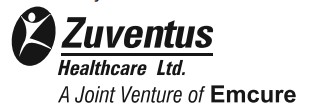
5119, Oberoi Garden Estates, D-Wing, Chandivali, Andheri (E), Mumbai 400 072. Registered Trade Mark of Zuventus.
About leaflet
Read all of this leaflet carefully before you start using this medicine because it contains important information for you.
- Keep this leaflet. You may need to read it again.
- If you have any further questions, ask your doctor or pharmacist.
- This medicine has been prescribed for you only. Do not pass it on to others. It may harm them, even if their signs of illness are the same as yours.
- If you get any side effects, talk to your doctor or pharmacist. This includes any possible side effects not listed in this leaflet. See section 4.
What is in this leaflet
1. What KetoPLAST is and what it is used for
2. What you need to know before you use KetoPLAST
3. How to use KetoPLAST
4. Possible side effects
5. How to store KetoPLAST
6. Contents of the pack and other information
1. What KetoPLAST is and what it is used for
KetoPLAST is a 70 cm2 medicated transdermal patch, with a flexible backing cloth. The adhesive side is covered with a plastic film. KetoPLAST is an anti-inflammatory preparation, non-steroid for transdermal use. It contains the active substance ketoprofen.
A transdermal ketoprofen patch is a medical product designed to deliver ketoprofen, a nonsteroidal anti-inflammatory drug (NSAID), through the skin and into the bloodstream. When applied to the skin, the patch releases Ketoprofen slowly over time. The drug is absorbed through the skin and enters the bloodstream, providing a steady level of pain relief over several hours.
Transdermal patches offer several advantages over oral medications, such as reduced gastrointestinal side effects because the drug bypasses the digestive system. They also provide a more consistent blood concentration of the drug.
KetoPLAST is used for the treatment of pain and inflammation following trauma (injury), sprains and bruises including muscle pain, stiffness, joint pain and low back pain.
KetoPLAST also used for following symptoms and conditions:
- Tennis Elbow: a common condition that causes pain and tenderness on the outer part of the elbow and forearm
- Peritendinitis: refers to inflammation or irritation of the tissue surrounding a tendon.
- Deformans Arthritis: joint pain, stiffness, swelling, and reduced range of motion
- Tendovaginitis: inflammation of the tendon sheath, which is the protective covering around a tendon
- Myalgia: refers to muscle pain or soreness
2. What you need to know before you use KetoPLAST
Do not use KetoPLAST:
- if you are allergic to ketoprofen, or any of the other ingredients of this medicine.
- if you have history of skin allergy (hypersensitivity) to tiaprofenic acid, fenofibrate, UV blockers or perfumes
- if aspirin or other NSAIDs causes you attacks of asthma, breathing difficulties, runny nose
or
nasal polyps (lumps in the nasal passage), hives (rashes), eyelid or lip swelling
- if you have history of any photosensitivity reaction
- if you have asthma
- if you have or have had stomach ulcer/bleeding or a history of gastrointestinal (stomach) ulcer
- if you have severe heart failure
- if you have liver or kidney problems
- if you are prone to bruising or bleeding or have any clotting/bleeding disorders, or if you are receiving any clotting treatment
- if you are pregnant or breastfeeding
- in children under 12 years of age
The plaster should not be used on open wounds or on skin with pathological changes such as eczema, acne, dermatitis, inflammation or infection of any nature or on mucous membranes of the body orifices.
Stop using KetoPLAST immediately if you experience any skin.
Do not expose treated areas to sunlight or UV light from a solarium during the treatment and the 2 weeks following its discontinuation.
Warnings and precautions
Talk to your doctor or pharmacist before using KetoPLAST:
- if you suffer with allergic conditions or have a history of allergy, especially when taking other pain killers, medicines to reduce fever and other NSAIDs
- if you have Crohn’s disease or ulcerative colitis, chronic dyspepsia, history of asthma
- if you suffer from liver, kidney or heart disease
- if you suffer from fluid retention
- exercise caution if elderly, as you are generally more prone to adverse side effects.
Prolonged or repeated use of the product can cause sensitisation (hypersensitivity).
The exposure to the sun or to UVA of areas treated with KetoPLAST can induce potentially serious cutaneous reactions (photosensitisation). Therefore, it is necessary to: -protect treated areas by wearing clothing during the treatment and for two weeks after its discontinuation to avoid any risk of photosensitisation. -wash your hands thoroughly after each application of KetoPLAST. Treatment should be discontinued immediately upon development of any skin reaction after application of KetoPLAST.
Children and adolescents
Bleeding in the stomach, sometimes severe, and stomach ulcers have been observed in some children treated with ketoprofen; the product should therefore be administered under the strict supervision of a doctor, who should assess the necessary dosage regimen case by case. The safety and efficacy of formulations of ketoprofen for the skin in children have not been established.
Other medicines and KetoPLAST
Tell your doctor or pharmacist if you are taking or have recently taken or might take any other
medicines. It is important to inform your doctor if you are taking methotrexate, anti-clotting agents, certain blood pressure or heart medication, anti-diabetic medication, or lithium.
Pregnancy, breast-feeding and fertility
If you are pregnant or breast-feeding, think you may be pregnant or are planning to have a baby, ask your doctor or pharmacist for advice before using this medicine.
Pregnancy
As the safety of Ketoprofen patch in pregnant women has not been established large dose or long-term use of this drug in pregnant women should be avoided.
Breast-feeding
KetoPLAST is not recommended in nursing mothers.
Driving and using machines
KetoPLAST can influence the ability to drive and use machines due to the possibility of dizziness or drowsiness occurring.
3. How to use KetoPLAST
Always use this medicine exactly as your doctor has told you. Check with your doctor or pharmacist if you are unsure.
The recommended dose is:
Adults: apply only one plaster per day, unless otherwise prescribed by your doctor. Not for use in children under 12 years of age.
The plaster should be used over the painful area and changed daily. Clean and dry the affected area before applying the plaster. Remove the protective film and apply the adhesive part directly to the skin.
If the plaster is to be applied to very mobile joints such as the elbow or knee, a bandage can be applied to the joint when bent, to keep the plaster in place.
Instructions for application
1. Fold the plaster in half by means of the perforated division of the plastic film.
2. Place the folded plaster on the clean and dry area of the body that hurts the most.
3. Strip off one half of the plastic film by the perforated edge, and smooth down the adhesive surface on to the area to be treated.
4. Remove the other half of the plastic film in the same way and smooth down the whole plaster
on to the area to be treated

Do NOT chew or swallow the plaster. FOR EXTERNAL USE ONLY
Duration of treatment
As prescribed by your doctor, but do not exceed 14 days.
If you use more KetoPLAST than you should
If you may have used more KetoPLAST than you should, talk to a doctor or a pharmacist immediately.
No case of overdose has been reported.
If you forget to use KetoPLAST
Do not worry, apply KetoPLAST as soon as you remember and then continue with the normal dose. Do NOT use a double application to make up for forgotten individual application.
4. Possible side effects of KetoPLAST
Like all medicines, this medicine can have side effects, although not everybody gets them. Stop using KetoPLAST and immediately seek urgent medical treatment if you get the following:
- Skin rash, hives, blistering, redness, burning, itching, skin peeling or bruises at the application site.
- Swelling of the face, runny nose, tight chest, wheezing (severe allergic reactions).
The following mild localised skin reactions on the KetoPLAST application sites have been reported:
- Uncommon (may affect up to 1 in 100 people): redness, burning sensation, itching, allergy Skin reactions, skin reaction during an exposure to the sun light.
The following side effects have also been reported:
Dermatological
- Rare (may affect up to 1 in 1,000 people): photosensitisation and urticaria. Cases of more severe reactions such as bullous or phlyctenular eczema which may spread or become generalized have occurred rarely.
- Not known (cannot be estimated from the available data): skin peeling and bruises at the application site
Renal and urinary disorders
- Very rare (may affect up to 1 in 10,000 people): cases of aggravation of previous renal insufficiency. Gastrointestinal disorders
- Not known (cannot be estimated from the available data): stomach ulcer
In case of active or suspected stomach ulcer, treatment should be discontinued immediately.
Reporting of side effects
If you get any side effects, talk to your doctor. This includes any possible side effects not listed in this leaflet. You can also report side effects directly: Website: www.zuventus.co.in and click the tab “Safety Reporting” located on the top of the home page. https://www.zuventus.co.in/drug-safety-reporting
By reporting side effects, you can help provide more information on the safety of this medicine.
5. How to store KetoPLAST
Store in a cool & dry place. Protect from light & moisture.
Keep out of reach of children.
Whenever a plaster is removed from the packaging, carefully re-seal the open side of the sachet to protect the remaining plasters from light.
Do not use KetoPLAST after the expiry date which is stated on the carton.
The expiry date refers to the product in unopened packaging, correctly stored.
Do not throw away any medicines via waste water or household waste. Ask your pharmacist how to throw away medicines you no longer use. These measures will help protect the environment.
6. Contents of the pack and other information
The active substance is ketoprofen 30 mg in one plaster.
Each plaster (7 cm X 10 cm) contains:
Ketoprofen IP …………………………...30 mg
Excipients q.s.
What KetoPLAST looks like and contents of the pack
KetoPLAST is a flesh-coloured 70 cm2 medicated plaster, with a flexible outer cover. The adhesive layer is protected by a plastic layer. 1 pack contains a pouch of 7 plasters.
Marketing Authorisation Holder
Zuventus Healthcare Limited
Zuventus House Plot No. Y2, CTS No: 358/A2,
near Nahur Railway Station, off Raycon IT Park Road,
Nahur West, Mumbai, Maharashtra 400078
This leaflet was last revised in July 2024.


